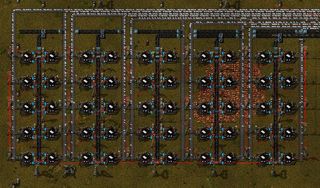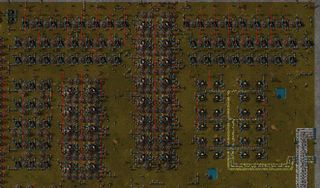See what a Factorio factory looks like after 500 hours of work
Hint: it's really, really big.
I've played some Factorio over the past few years, typically spending long hours building up my automated factory, eventually realizing I didn't plan it very well, staring glumly at the tangled mess of resource-carrying conveyor belts for a while, then starting a new game to try to build a better one based on the lessons I learned.
Not so for Redditor Zytukin. He started his first factory after buying the resource management simulation game in January, and never stopped working on it. Rather than start over on a new map like I always do, Zytukin took the time to demolish and rebuild the areas that needed fixing. 500 hours later, the factory is massive, as you'll see in the gifs and images here.
Zytukin was nice enough to answer some of my questions over email, and send me a saved game so I could take a little run through the factory for myself. Well, not a little run: it takes ages to run through it because it's incredibly massive. Here I am sprinting through the spawling solar panel farm:
Zytukin agrees that besides building everything, one of the toughest parts of working on such a massive project is simply getting from one end of the factory to the other.
"Main problem is travelling around in such a large factory," Zytukin told me. "I built a separate rail line and a few trains just to travel around in the factory and bring materials when building things. With it being such a large scale, it can take several rail cars worth of stuff to build or disassemble production areas, and can easily take 5 mins to walk from one area to another."
Alien life in Factorio grows hostile when pollution from your factory drifts over their nests, at which point they'll attack both you and your machines. With such a huge factory, were the natives a problem?
"My game is in peaceful mode most of the time since I am far more interested in the building aspect of the game then fighting," said Zytukin, "but I do have defenses set up and occasionally turn off peaceful mode to have some action."
The biggest gaming news, reviews and hardware deals
Keep up to date with the most important stories and the best deals, as picked by the PC Gamer team.
Above you can see me launching one of Zytukin rockets—mainly because I've never advanced to rocket silo technology in my own games. Majestic! And not to worry, there are plenty of spare rocket silos, as you can see.
I also asked if Zytukin used mods or console commands. "The factory uses a lot of raw materials so I have used console codes to place large patches of ore far away from the factory and use trains to deliver it. This could also be done with the RSO (Resource Spawner Overhaul) mod automatically."
Among the list of mods Zytukin uses are FAT Controller (it lets you remotely control trains), Landfill (which lets you change water tiles to land), Foreman (a blueprint management mod), Blueprint Flipper (lets you mirror your blueprints) Color Coding (you can color code trains based on what they're hauling), and Launch Control (for launching rockets automatically).
Below you can see a few more images of the 500 hour factory, and the full gallery with descriptions here. As for Zytukin's plans for the future:
"Don't have any plans besides build, build, and build some more. That's what's nice about a sandbox game with a nearly unlimited map. You can just build non-stop until the game engine or your computer can't handle it anymore. Only time will tell how the factory looks after another 500 hours."





Chris started playing PC games in the 1980s, started writing about them in the early 2000s, and (finally) started getting paid to write about them in the late 2000s. Following a few years as a regular freelancer, PC Gamer hired him in 2014, probably so he'd stop emailing them asking for more work. Chris has a love-hate relationship with survival games and an unhealthy fascination with the inner lives of NPCs. He's also a fan of offbeat simulation games, mods, and ignoring storylines in RPGs so he can make up his own.
Most Popular

